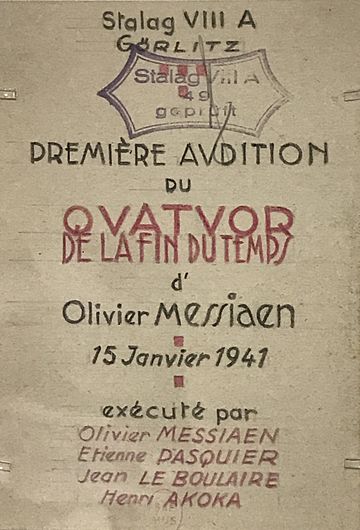Quatour pour la fin du temps facts for kids
Quick facts for kids Quatuor pour la fin du Temps |
|
|---|---|
| Chamber music by Olivier Messiaen | |

Invitation to the premiere
|
|
| English | Quartet for the End of Time |
| Performed | 15 January 1941: Görlitz |
| Duration | 50 minutes |
| Movements | eight |
| Scoring |
|
Quatuor pour la fin du temps is a famous piece of chamber music by the French composer Olivier Messiaen. In English, it's often called Quartet for the End of Time. This music is special because it's written for an unusual group of four instruments: clarinet, violin, cello, and piano.
The piece has eight different parts, called movements. It takes about 50 minutes to play the whole thing. The first performance of this quartet happened in a very unique way in 1941. It's considered a very important work in the history of 20th-century classical music.
How the Quartet Was Created
There's a special story behind why Messiaen wrote this piece for these four instruments. In 1940, during World War II, Germany took over France. Messiaen was captured by the German army and became a prisoner of war.
While being taken to the prison camp, Messiaen met another prisoner, Henri Akoka. Henri was a clarinet player. Messiaen showed him some ideas for a clarinet piece he was working on. Two other professional musicians were also prisoners there. They were Jean le Boulaire, a violinist, and Étienne Pasquier, a cellist.
Messiaen decided to write the Quatuor for these three musicians, with himself playing the piano. This mix of instruments is quite rare.
First Performance in a Prison Camp
The quartet was first played in Görlitz, Germany. This place is now called Zgorzelec and is in Poland. The first performance happened on January 15, 1941.
The audience was made up of about four hundred prisoners of war. German prison officers were also there, sitting in the front. The music must have sounded very new and different to the audience. But everyone listened quietly and politely. Soon after this, Messiaen was released from prison and went back to France.
What Inspired the Music?
Messiaen was inspired by words from the Bible. These words say that "There shall be time no longer." This idea also connects to the music itself.
Messiaen didn't write the music with a regular, steady beat. Unlike most songs, the length of the musical bars keeps changing. During the war, Messiaen had heard enough of soldiers marching to a simple one-two-three-four beat. So, in his music, the rhythms grow from small, unique patterns.
The Eight Movements
The Quatuor has eight different parts, or movements. Each movement has its own name and feeling.
Movement 1: Crystal Liturgy
The first movement is called “Liturgie de cristal” (“Crystal Liturgy”). It sounds like birds waking up in the morning. All four instruments play together in this part.
Movement 2: Song for the Angel
The second movement is “Vocalise, pour l'Ange qui annonce la fin du Temps” (“Song for the Angel who announces the end of time”). The full quartet plays this. The clarinet takes a break in the middle section.
Movement 3: Abyss of Birds
The third movement is called “Abîme des oiseaux” (“Abyss of birds”). Only the clarinet plays in this part. It's played extremely slowly. The clarinet player needs to be very good at controlling their breath.
Movement 4: Interlude
The fourth movement is “Intermède” (“Interlude”). The violin, cello, and clarinet play this part. It's a fast and lively section.
Movement 5: Praise to Jesus
The fifth movement is “Louange à l'Éternité de Jésus” (“Praise to the eternity of Jesus”). The cello plays a beautiful, slow melody. The piano plays simple chords to support it. The cellist needs great control of their bow.
Movement 6: Dance of Fury
The sixth movement is called “Danse de la fureur, pour les sept trompettes” (“Dance of the Fury, for the seven trumpets”). All four instruments play together. They play almost the same notes, in unison, for nearly the whole movement.
Movement 7: Tangle of Rainbows
The seventh movement is “Fouillis d'arcs-en-ciel, pour l'Ange qui annonce la fin du Temps” (“Tangle of rainbows, for the Angel who announces the end of time”). The full quartet plays this. Some music from the second movement is heard again. It's like hearing the angel being surrounded by a rainbow.
Movement 8: Praise to Immortality
The eighth and final movement is “Louange à l'Immortalité de Jésus” (“Praise to the immortality of Jesus”). This part is for the violin and piano. It's meant to sound like a person rising up to meet their god. The violin finishes on a very high, special harmonic note.
See also
 In Spanish: Cuarteto para el fin de los tiempos para niños
In Spanish: Cuarteto para el fin de los tiempos para niños

